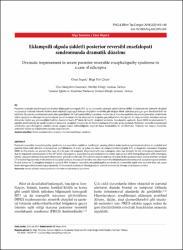Eklampsili olguda şiddetli posterior reversibl ensefalopati sendromunda dramatik düzelme
Künye
Sagut O, Piri Cinar B. [Dramatic improvement in severe posterior reversible encephalopathy syndrome in a case of eclampsia]. FNG & Bilim Tıp Dergisi 2016;2(2):145-148. doi: 10.5606/fng.btd.2016.026Özet
Posterior reversibl ensefalopati sendromu; bilgisayarlı tomografi (BT) ya da manyetik rezonans görüntüleme (MRG) incelemesinde; simetrik oksipital ve pariyetal loblarda ödemle birlikte akut-subakut başlangıçlı bilinçte değişiklik ve körlük gibi değişik klinik tablolara yol açan geri döndürülebilir bir tablodur. Bu yazıda preeklampsi tanısı olan gebeliğinin 34. haftasında bilinç bozukluğu nedeniyle acil servise getirilen, bu sırada jeneralize tonik klonik nöbet geçiren ve eklampsi tanısı konularak genel anestezi altında sezeryan ile doğumu gerçekleştirilen 16 yaşında bir olgu sunuldu. Ameliyat sonrası dönemde hiçbir şey göremediğini belirten hastanın beyin BT’sinde iki taraflı oksipital kortekste hipodansite saptandı. Beyin MRG incelemesinde T2 ağırlıklı görüntülerde iki taraflı posterior temporal, oksipital bölgelerde ve frontal alanlarda intensite artışı saptandı. Posterior reversibl ensefalopati sendromu, geri dönüşümü olabilen ancak uygun tedavi edilmediğinde beyinde hasar bırakabilen bir sendromdur. Tedavisi; kan basıncı kontrolü, antiödem tedavi ve nöbet kontrolünden oluşmaktadır. Posterior reversible encephalopathy syndrome is a reversible condition resulting in varying clinical states such as symmetrical edema in occipital and parietal lobes with altered consciousness and blindness of acute or subacute onset at computed tomography (CT) or magnetic resonance imaging (MRI). In this article, we present the case of a 16-year-old pregnant diagnosed with pre-eclampsia, who was brought to the emergency department due to impaired consciousness in the 34th week of pregnancy, experiencing generalized tonic-clonic seizure and after being diagnosed with eclampsia, whose cesarean delivery was performed under general anesthesia. The patient stated total loss of vision in the postoperative period and her cerebral CT revealed hypodensity in the bilateral occipital cortices. Increased intensity was observed in the bilateral posterior temporal, occipital regions and the frontal zones on T2 weighted images at cerebral MRI. Posterior reversible encephalopathy syndrome is a reversible syndrome, but one that can cause brain damage unless treated appropriately. Its treatment consists of blood pressure control, antiedema therapy and seizure control.


















